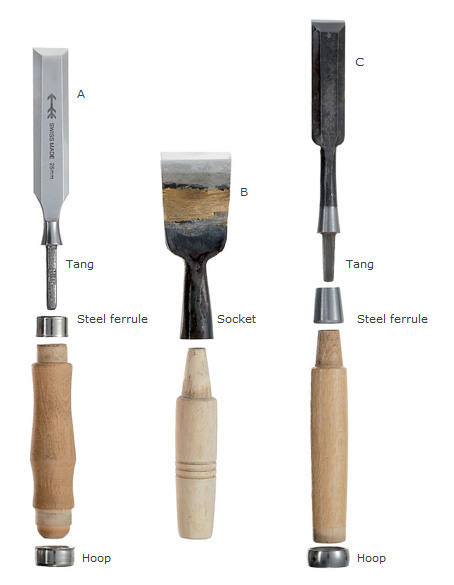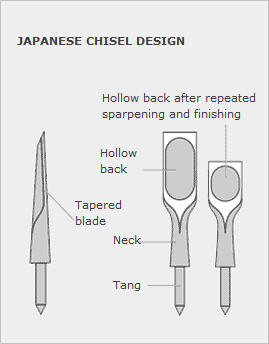Chisels
Expert knowledge - Chisels
We distinguish between finishing chisels for light to moderate work and striking chisels for heavy-duty work. Finishing chisels are usually pounded by hand. They therefore have no steel hoops at the handle end.
Striking chisels, on the other hand, are driven by striking the tool (wooden mallet for Western chisels and iron-headed hammer for Japanese chisels). With regard to the blade, they are there fore designed more sturdily, and have a hoop at the handle end.
We distinguish between the following types:
- A. Tang chisels
Classic design, ensuring firm anchoring of the blade in the handle. On cheap tools without an additional steel ferrule, the handles may split under heavy blows.
- B. Socket chisels
This design allows a continuous transition from the neck to the handle and thus comfortable ergonomics. Through the conical fit of the socket, strong forces can be transmitted during striking.
- C. Japanese chisels (Nomi)
This design combines the benefits of both types above.

Wherever high precision is required for working solid wood, for jointwork in the manufacture of fine furniture, or for the making of musical instruments, Nomi are indispensable. They have the following advantages:

- Blades of two-layered steel
Soft iron, protects the blade against cracking and absorbs the shocks of the hammer blows, forge-welded with a thin layer of extremely hard carbon-steel (with the exception of HSS Nomi). The hardness values are 62-63 and 66 (HSS steel) on the Rockwell scale.
- Tapered blades
The blade is set at a slight angle to the tang to increase the working depth to nearly double the blade length.
- Integral design
The neck is seamlessly integrated in the handle and therefore lies comfortably in the hand. The solid conical steel ferrule protects the handle against fracture or becoming loose when struck with the iron-headed hammer.
- Hollow-ground back
The hollow relief (ura) on the back of the blade reduces the contact surface and therefore also the friction and the required cutting force. It also simplifies sharpening, as only the edges of the hard carbon-steel back of the blade need to be lapped. Due to the abrasion during sharpening, the straight cutting edge remains intact, even though the blade becomes shorter through sharpening over time (see illustration above).
- Sharpening Japanese chisels
Use only fine-grained Japanese waterstones with grit 1000-2000 for sharpening and 1000-4000 for finishing. Work on the bevel and rear side until the concave relief is outside the cutting edge (see illustration below). The back lies completely flat on the stone. Make sure that the sharpening and finishing stone is 100% flat!
As a rule, these are made of alloyed steels with relatively sturdy blades and little danger of chipping. In particular the finely manufactured DICK chisels in traditional central European design have proven ideal for universal use.
Traditional Chinese chisels are convincing in terms of their durable, crack-resistant HSS steel blades, which also withstand rough treatment during restoration or joiner’s work. The working of wear-inducing composite materials is also no problem for these chisels. The tapered shape of the blades is advantageous for working into corners and undercutting. The value for money of these chisels is unbeatable.
Discover our chisels
ChiselsJapanese type
Hybrid type
Western type
Chinese chisels
Chisel Accessories / Replacement parts
